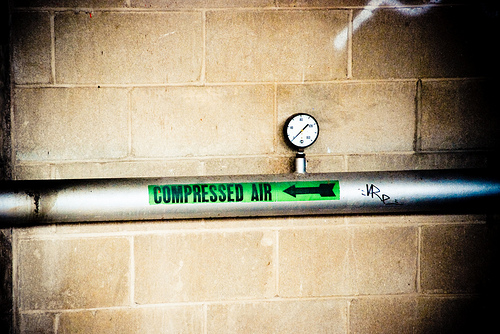Compressed Air: Difference between revisions
Jump to navigation
Jump to search
| Line 21: | Line 21: | ||
* inflatable structures (greenhouses, tents, other temporary installations) | * inflatable structures (greenhouses, tents, other temporary installations) | ||
* cooling (possibly via [http://en.wikipedia.org/wiki/Vortex_tube vortex tube]); for making [http://openfarmtech.org/wiki/Freeze_Dried_Fruit_Powders freeze-dried] fruit powders | * cooling (possibly via [http://en.wikipedia.org/wiki/Vortex_tube vortex tube]); for making [http://openfarmtech.org/wiki/Freeze_Dried_Fruit_Powders freeze-dried] fruit powders | ||
* using vortex tube for separation of atmospheric gases: yields nitrogen (for food preservation) and oxygen (to co-fire with gas and reach higher temperatures for metallurgical applications) | |||
* generate compressed air via (solar) heat engine that directly powers an air compressor | * generate compressed air via (solar) heat engine that directly powers an air compressor | ||
Revision as of 16:27, 18 January 2011
Compressed air is one of the basic utilities, next to water, electricity and gas. In some situations, it can replace these other utilities, providing flexibility (see product ecology, below). It could be generated by small wind installations which are mechanically coupled to air compressor. Alternatively, solar photovoltaic cells could power an electric air compressor, although this arrangement is likely more expensive.
(image from Flickr user Dakohlmeyer via CC license)
Applications and product ecology
- for energy storage (CAES, compressed air energy storage), see energy storage Wikipedia
- compressed air could be "co-fired" with biogas for electricity generation, saving gas
- pneumatic motors for all sorts of uses, replacing electric or hydraulic motors
- run power tools, examples here and also here
- pneumatic transportation (see Treehugger article on FoodTubes)
- compressed air water pump
- various ventilation uses (e.g. air exchange in greenhouses, Passivhaus etc.), as an alternative to electric fans
- drying of biomass (... food, manure, etc.) before further uses, such as combustion, pyrolysis
- aeration of water in aquaculture
- control air flow in updraft and other gasifiers
- inflatable structures (greenhouses, tents, other temporary installations)
- cooling (possibly via vortex tube); for making freeze-dried fruit powders
- using vortex tube for separation of atmospheric gases: yields nitrogen (for food preservation) and oxygen (to co-fire with gas and reach higher temperatures for metallurgical applications)
- generate compressed air via (solar) heat engine that directly powers an air compressor
